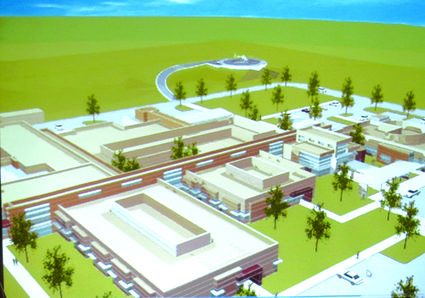Post-affiliation, a new focus for healthcare district
The Forde Files No 97

Tina Fisher Cunningham
Above, the Tehachapi Critical Access Replacement Hospital as it will look when open, 3Q 2016. Diagonally from left front , the medical-surgical wing, center, obstetrics, entry lobby, administration; diagonally to the left from top right, helicopter pad, emergency, main corridor and back-of-house utilities. Not shown, cafeteria, healing garden. Graphic courtesy TVHD and SWA Architects.
As the Tehachapi Critical Access Replacement Hospital moves toward completion, and affiliation with Adventist Health on the horizon, the Tehachapi Valley Healthcare District is re-defining its raison d'être.
Once the hospital is leased to Adventist – should the public approve the affiliation on Nov. 4, 2015 – the district board of directors will focus on developing new ways to address community health issues. The district has begun that mission with a Community Health Needs Assessment, presented at the district board meeting June 16, 2015 (see sidebar).
The primary job of the board of directors has been to manage the existing 1956 hospital and, in recent years, its additional mission has been to build a new hospital to replace the old facility – a goal made more urgent by California's updated seismic requirements that call for closure of non-compliant hospitals. To maintain services, the Tehachapi hospital physical plant has spread to trailer outbuildings and nearby 100-year-old houses on West E Street.
The board of directors has fought a bruising battle to pave the way for the replacement hospital, winning public approval for two construction bonds and overcoming legal and environmental challenges. Following an early change of architect, a year's forced California Environmental Quality Act (CEQA) delay and another six-month slowdown due to construction difficulties, the board was looking at a funding shortfall. The new building on Capital Hills could be opened, but several of the wings, including obstetrics, would be unfinished shells to be completed later when funds were available.
Eugene Suksi, district CEO since July 2014, proposed the concept of affiliation with a large health care organization. The small independent rural hospital would seek a big strong partner with medical and financial resources.
"As of last October, the board was not sure [about affiliation]," Suksi said. The district sent out Requests for Proposal (RFP). "I wasn't sure anyone would respond." Adventist Health submitted the superior proposal, with the added sweetener of $25 million cash to finish hospital construction.
Affiliation negotiations with Adventist are "in full swing," district counsel Scot Nave reported. He said the district has provided 4,000 documents to Adventist.
"It's been quite a process," Nave said.
Under the proposed agreement, Adventist will lease and run the hospital for 25 to 30 years. The district will still own it.
Public hearings on the affiliation proposal will precede the election on Nov. 4. Should the public approve the affiliation, the Adventist lease will begin Jan. 1, 2016.
The initial Community Health Needs Assessment survey, reported to the June 16, 2015 district board meeting by Carolyn St. Charles of HealthTech, revealed that people are concerned about drug and alcohol abuse in the community at large but it is not necessarily a priority in their own families. The most important concern was access to healthcare services. The survey showed that:
*57.7 percent of the respondents rated their overall health as good and 23.7 percent rated their overall health as fair;
*64.4 percent reported they or someone in their immediate family had high blood pressure; 42.2 percent had diabetes and 42.2 percent had asthma;
*2.1 percent said they did not have any kind of health insurance; 46.1 percent had private insurance and 42 percent had Medi-Cal; 20.2 percent had Medicare;
*42.2 percent have regular appointments with their primary care provider throughout the year and 81.6 percent said their children have regular appointments;
*91.7 percent make an appointment with their primary care provider if they have an immediate need while 5.2 percent go to the emergency room.




